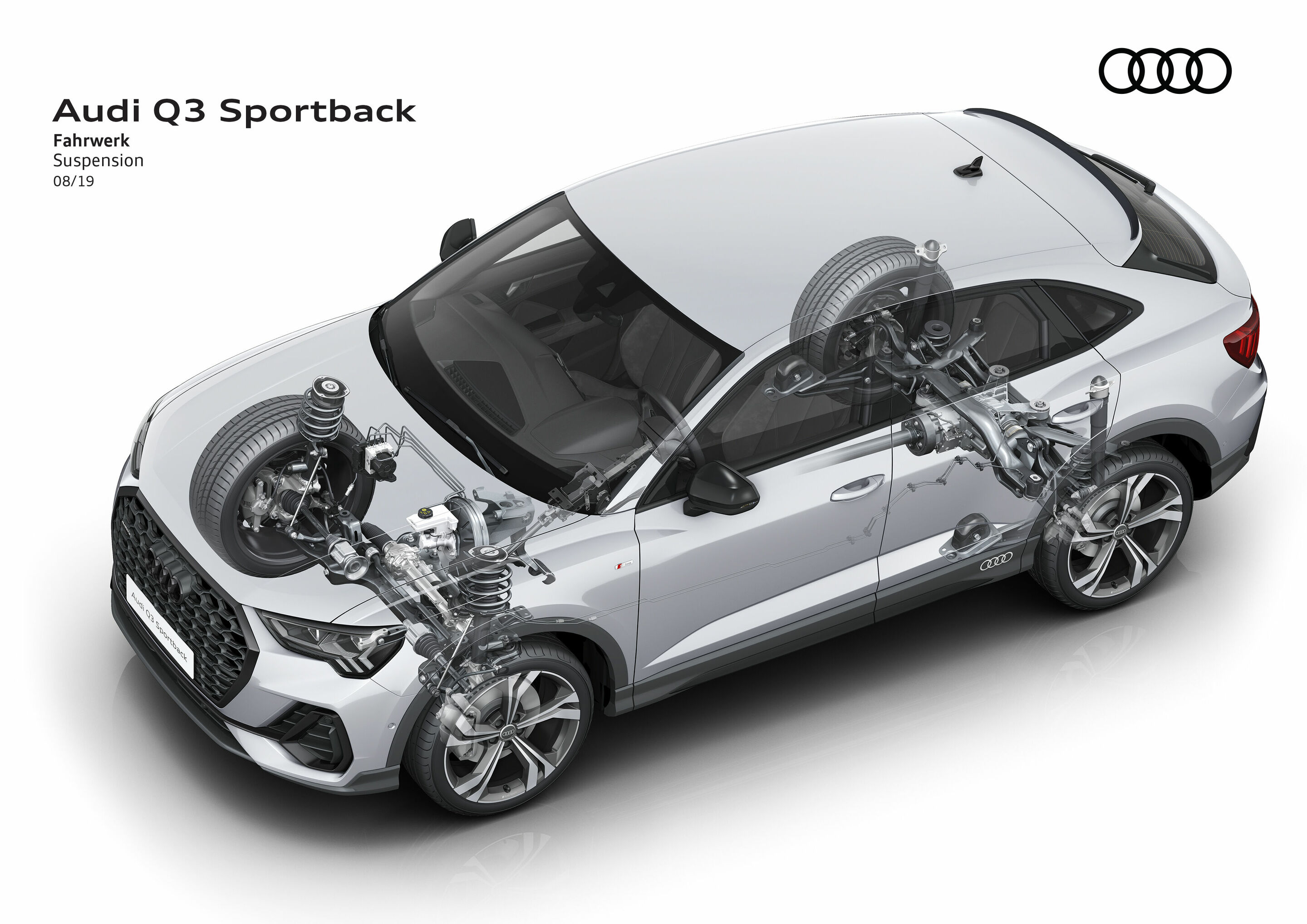Suspension
Back to overviewThe Audi Q3 Sportback offers driving fun on various terrains. In the city, on long-haul routes or on easy terrain – the compact crossover is a dynamic all-around performer. The suspension is a defining feature of this versatile character: It conveys a high level of agility and confident comfort at the same time – a strength that stems from the long wheelbase.
Versatile: agility on-road and off-road
The Audi Q3 Sportback is fitted with a sport suspension with a taut spring/damper setup as standard. This provides the SUV coupé with enormous agility on curvy roads. The customer can select the comfort suspension as an alternative at no extra cost. This allows the all-around performer to display its balanced driving behavior and great poise on long journeys in particular. The suspension with damper control is a further option available. Its control unit processes the signals transmitted by the acceleration and wheel travel sensors, for example, and measures the body’s sprung mass vibrations. Using this information, it adjusts the optimum damper force for each wheel at millisecond intervals: Low in the case of hard surface irregularities on poor roads, high to support the body when driving quickly through corners, braking or accelerating heavily. With the standard dynamic handling system Audi drive select, the driver can specify the basic working method of the dampers as one of the three profiles comfort, auto and dynamic, increasing the bandwidth between soft rolling motion and taut handling even more.
In general, Audi drive select accesses the engine and transmission characteristics as well as steering assistance. The driver can choose between six different tunings: In addition to the standard setting, the comfort, dynamic, and efficiency programs are available for selection, as well as a customized driver setup. For off-road use, the offroad mode can be used. In this mode, the electronic stabilization control switches the traction control system over to off-road mode. As an option, the hill descent control can provide support here. It constantly maintains the speed specified by the driver (up to 30 km/h (18.6 mph)) on a downhill gradient of more than six percent by applying the brake automatically. In addition, a display in the MMI provides information about the relevant incline angle. The electronic stabilization control (ESC) can also be switched off completely upon request. In this case, the possible wheel slip is virtually unrestricted. Low slip control is still provided in the low speed range only so the vehicle can move off better on ice, deep snow or sand.
Sporty, precise handling: suspensions, steering, wheels
The front axle of the Audi Q3 Sportback is designed as a McPherson structure with wishbones at the bottom. The track width is 1,584 mm (62.4 in). In the rear, there is a four-link structure with a track width of 1,576 millimeters (62 in). The coil springs and the shock absorbers are separate, increasing the volume of the luggage compartment.
The standard progressive steering already has a sporty gear ratio of 14.8:1 in the neutral position. It becomes increasingly direct the more the driver turns the steering wheel, until it reaches a gear ratio of 11.4:1 when the steering wheel is turned all the way. This allows the SUV coupé to be moved with agility and precision using little steering effort when maneuvering and driving through tight corners. The electromechanical power assistance is designed to fit in with this: The slower the car drives the more its intensity increases.
As standard, the Audi Q3 Sportback drives on 17-inch light-alloy wheels whose 215/65 tires are distinguished by their particularly low rolling resistance. 18-inch cast aluminum wheels with 235/55 tires are the first option level. 19inch wheels ‑with 235/50 or 255/45 tires are available as an alternative. Topping the range are 20-Inch wheels from Audi Sport with 255/40 tires. Depending on the engine type, the ventilated brake disks on the front axle are up to 340 millimeters (13.4 in) in diameter, and the rear brake disks reach a maximum of 310 millimeters (12.2 in).
All terms marked in the text are explained in detail in the technology lexicon at www.audi-mediacenter.com/en/technology-lexicon.
The equipment, data and prices specified in this document refer to the model range offered in Germany. Subject to change without notice; errors and omissions excepted.
